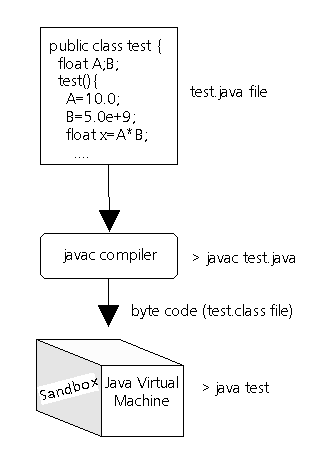
| Home : Course Map : Chapter 1 : Java : |
|
The Java Procedure
|
| JavaTech |
| Course Map |
| Chapter 1 |
| Introduction History What is Java? Versions Java 5.0 Features Java Process Tools Documentation Compatibility Getting Started Simple Applet Simple Application Starters Exercises |
|
Supplements |
| About
JavaTech Codes List Exercises Feedback References Resources Tips Topic Index Course Guide What's New |
|
The essential steps to creating and running Java programs go as follows:
The following figure illustrates these steps:
You create the code with a text editor and save it to a file with the ".java" suffix. All Java source code files must end with this type name. The first part of the name must match the class name in the source code. In the figure the class name is Test so you must therefore save it to the file name Test.java. We will discuss what class actually means in later chapters. With the javac program, you compile this file as follows: C:> javac Test.java This creates a bytecode file (or files if the code file included more than one class) that ends with the ".class" type appended. Here the output is Test.class. The bytecode consists of the instructions for the Java Virtual Machine (JVM or just VM). The JVM is an interpreter program that emulates a processor that executes the bytecode instructions just as if it were a hardware processor executing native machine code instructions.
The platform independence of Java thus depends on the prior creation of JVMs for different platforms. The Java bytecode can then run on any platform in which the JVM is available and the program should perform the same. This Write Once, Run Anywhere approach is a key goal of the Java language.
References & Web Resources
Latest update: Oct. 10, 2004 |
|
Tech |
|
Physics |
